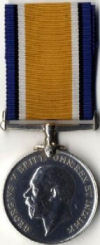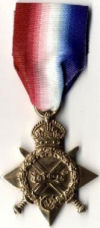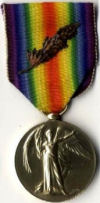

WW1 Army and RFC Campaign Medals
by Ian Sewell
This article was originally published in the May 2006 edition of Soul Search, the journal of The Sole Society
I have now transcribed all the campaign medal roles for the Army and RFC (which at the time was still a part of the army) covering the period of the first world war for the Saul, Solley and Sewell names.
In total there are 1,697 names recorded as being awarded a campaign medal consisting of combinations of the British War Medal, the Victory Medal and the 1914-15 Star.
The British War medal was awarded to all Commonwealth soldiers who fought in any theatre in the conflict including the later conflicts in Russia up to 1920. It was normally awarded in conjunction with the appropriate Victory medal, though sometimes this was awarded by the soldiers own country thus the records in the NRA could hold one award the other being recorded by the appropriate country.
The 1914 Star was awarded to all soldiers who served in the BEF from the outbreak of hostilities until the 22/23 November 1914, with a Bar (or Rose Clasp) being awarded to those who were actually under fire between those dates. The majority of these medals were issued to the standing pre-war army or the ‘Old Contemptibles’. The 1914-15 Star was awarded to those who served up to the end of 1915 who had not qualified for the 1914 Star.
Whilst looking at these records it is important to know that these medals were awarded automatically to the ranks, even if they died in the war. Officers however had to apply for the medals and so fewer are recorded.
The record consists of the name, rank and serial number of each regiment the soldier served in. Sometimes this could as many as four regiments though the majority only served in one or two regiments. The rank noted is usually the highest rank that the soldier attained in that regiment. In addition to the medals awarded there is sometimes a date of service and theatre where the award was made and some additional notes. These are often useful notes on date of discharge, death or commission of the soldier.
With the loss of so many records the medal index can give some badly needed information for those who are tracking down their ancestors in the war. With this in mind it is interesting to see how many medal rolls exist compared to that of service records. This is not an exact calculation, as many of the records that remain include those who would not qualify for medals and there are a number of soldiers who appear in both WO63 and 364 records but it will show us just how many records have been lost:
|
Name |
WO363 |
WO364 |
Total |
Medal Rolls |
% of Records to Medal Roll |
|
Saul |
102 |
38 |
140 |
287 |
48.7 |
|
Sewell |
345 |
189 |
534 |
1186 |
45.0 |
|
Solley |
56 |
34 |
90 |
222 |
40.5 |
|
Total |
|
|
764 |
1695 |
45.0 |
A number of the soldier recorded in the British records did come from commonwealth countries including Frank Herbert Sewell of the 3rd Natal Mounted Regiment, F Saul of the Canadian Fort Garry Horse, Ernest Sewell of the North Rhodesian Rifles, S E Sewell of the Madras Artillery, John Thomas Sewell and William Solly of the Royal Canadian Regiment and John Sooley of the Royal Newfoundland Regiment. There were also 10 soldiers serving in the British West India Regiment.
As expected the county regiments where our names are concentrated are well represented with 49 in the Borders, 43 in the Durham Light Infantry, 23 in the East Kent and 21 in the West Kent, 19 in the Norfolk’s and 55 in various Yorkshire regiments. The scale of the army can also be seen in the fact that representatives of the three names can be found in all 29 Battalions of the London regiment.
Given that this was the first war were non-front line infantry units were used in numbers it is not surprising that 123 names are recorded in the Army Service Corp, 117 in the Royal Engineers, 118 in the Royal Field Artillery and 87 in the Garrison Artillery.
As stated most of the soldiers were not officers, but there were 20 2nd Lieutenants, 20 Lieutenants, 15 Captains, 4 Majors, 2 Lt Colonels and one Brigadier General (Johnathon William Sewell of the Royal Engineers) . Other ranks included Chaplin, Shoe Smith, Strapper, Reverend and Dresser. The vast majority, 1,069, were of course privates.
These details are from the first regiment recorded for the soldier. Many soldiers served in more than one regiment whether from having his initial units destroyed in combat or being wounded and then posted to another unit on his return. Many soldiers served in the Labour Corps both at home at in France but whilst 24 served in the unit as their first and often only posting a further 122 served as their second or third regiment.
There were 35 soldiers awarded just the British War Medal, the rest being awarded it with the Victory Medal, 45 Soldiers were awarded the 1914 with Clasp with 71 awarded the 1914 Star and 482 were awarded the 1915 Star. Some of the other medals awarded included the Indian Garrison Medal (6), the Territorial Forces Medal (6) and the Good Service Medal (3).
From the notes we can also see that 113 soldiers obtained a 392 discharge (unfit for service), 83 obtained class Z discharge (to reserves), 99 were either killed in action or died of wounds and a further 3 soldiers were recorded as being Prisoners of War and one as having deserted.


